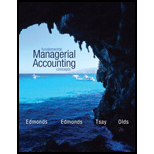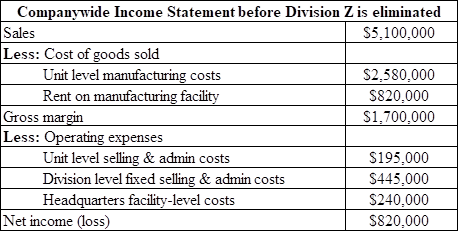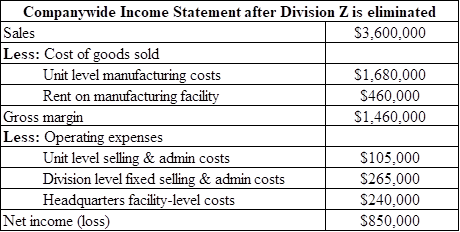
a.
Whether to eliminate Division Z.
a.
Explanation of Solution
Special order decisions: Special order decisions include circumstances in which the board must choose whether to acknowledge abnormal customer orders. These requests or orders normally necessitate special dispensation or include a demand for lesser price.
Outsourcing: It can be termed as conveying all or part of an activity to a supplier or a provider. While outsourcing was initially limited to fundamental activities, it as of now invades the administration of numerous organizations.
Opportunity cost: Opportunity cost is the forfeit of certain benefits such as cost savings, incomes, which is surrendered by not picking an option. Opportunity costs are applicable in decisions where the acknowledgment of one option disqualifies the likelihood of selecting different alternatives.
Determine the contribution to profit
Therefore the contribution to profit is -$30,000.
From the results obtained above, the contribution to profit is negative at -$30,000. Hence the Division Z should be eliminated.
Therefore Division Z should be eliminated.
Preparing the companywide income statement before and after eliminating Division Z.
Explanation of Solution
The companywide income statement before eliminating Division Z is as follows:

Table (1)
(Refer excel for workings)
The companywide income statement after eliminating Division Z is as follows:

Table (2)
(Refer excel for workings)
b.
Whether the recommendations in Requirement A changes if the units increase to 30,000 units by comparing differential revenue and avoidable cost for Division Z.
b.
Explanation of Solution
Initiate by calculating the selling price per unit and the cost per unit that will change in respect to the quantity of units produced and traded. The result is divided with the total cost for each category by 30,000 units to get cost per unit. The headquarters facility-level costs are not considered from the investigation since these costs are not avoidable.
Determine the selling price per unit
Therefore the selling price per unit is $50.
Determine the unit level
Therefore the unit level manufacturing costs is $30.
Determine the unit level selling and administrative costs
Therefore the unit level selling and administrative costs is $30.
Determine the contribution to profit
The comparison between differential revenue and avoidable cost is determined in the below step.
Therefore the contribution to profit is $225,000.
From the results obtained above, Division Z would give a contribution to profit at 45,000 units. Hence the division should not be eliminated. Additionally, it is vital to contemplate development prospective before choosing to eliminate a segment.
Therefore Division Z should not be eliminated.
c.
Whether to operate the division with volume of 30,000 units or it should be closed.
c.
Explanation of Solution
The reasons on whether to operate the division with volume of 30,000 units or it should be closed is as follows:
- It is mentioned that Company BC is paying $360,000 to lease the manufacturing facility for Division Z.
- The business could earn $380,000 ($320,000-$150,000) by subleasing the manufacturing facility.
- By operating the division, the organization is allowing up the chance to sublease the office.
- This is an opportunity cost that would be avoidable by eliminating Division Z.
- Consequently, it must be incorporated into the investigation. If the volume is 45,000 units Division Z contributes $225,000 as profit.
Determine the profit or loss of the division
Therefore the loss of the division is -$155,000.
When the opportunity cost is considered, the profit turns into a loss of $155,000. According to these conditions, Division Z should be eliminated.
Therefore Division Z should be eliminated.
Want to see more full solutions like this?
Chapter 6 Solutions
Fundamental Managerial Accounting Concepts with Access
- Please provide the solution to this accounting question using proper accounting principles.arrow_forwardI need help with this financial accounting question using the proper accounting approach.arrow_forwardCan you explain this general accounting question using accurate calculation methods?arrow_forward

 AccountingAccountingISBN:9781337272094Author:WARREN, Carl S., Reeve, James M., Duchac, Jonathan E.Publisher:Cengage Learning,
AccountingAccountingISBN:9781337272094Author:WARREN, Carl S., Reeve, James M., Duchac, Jonathan E.Publisher:Cengage Learning, Accounting Information SystemsAccountingISBN:9781337619202Author:Hall, James A.Publisher:Cengage Learning,
Accounting Information SystemsAccountingISBN:9781337619202Author:Hall, James A.Publisher:Cengage Learning, Horngren's Cost Accounting: A Managerial Emphasis...AccountingISBN:9780134475585Author:Srikant M. Datar, Madhav V. RajanPublisher:PEARSON
Horngren's Cost Accounting: A Managerial Emphasis...AccountingISBN:9780134475585Author:Srikant M. Datar, Madhav V. RajanPublisher:PEARSON Intermediate AccountingAccountingISBN:9781259722660Author:J. David Spiceland, Mark W. Nelson, Wayne M ThomasPublisher:McGraw-Hill Education
Intermediate AccountingAccountingISBN:9781259722660Author:J. David Spiceland, Mark W. Nelson, Wayne M ThomasPublisher:McGraw-Hill Education Financial and Managerial AccountingAccountingISBN:9781259726705Author:John J Wild, Ken W. Shaw, Barbara Chiappetta Fundamental Accounting PrinciplesPublisher:McGraw-Hill Education
Financial and Managerial AccountingAccountingISBN:9781259726705Author:John J Wild, Ken W. Shaw, Barbara Chiappetta Fundamental Accounting PrinciplesPublisher:McGraw-Hill Education





